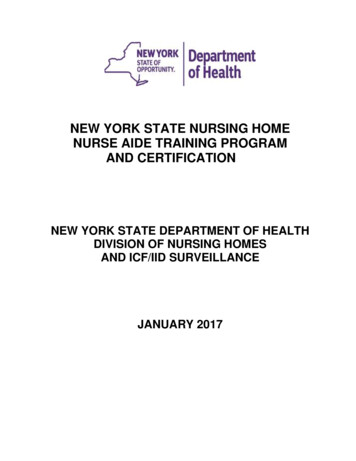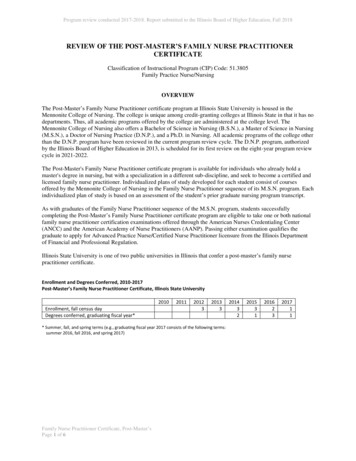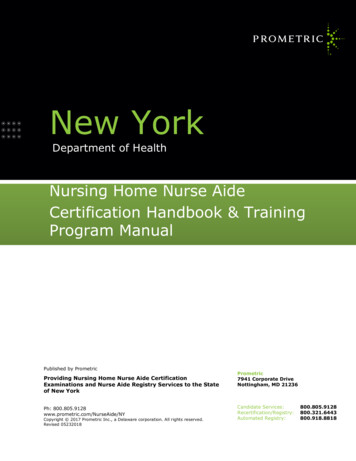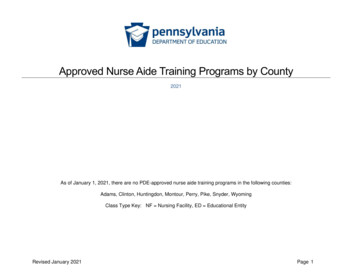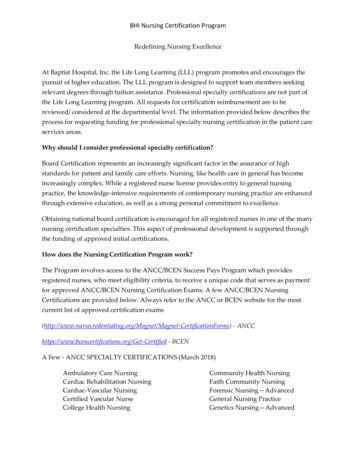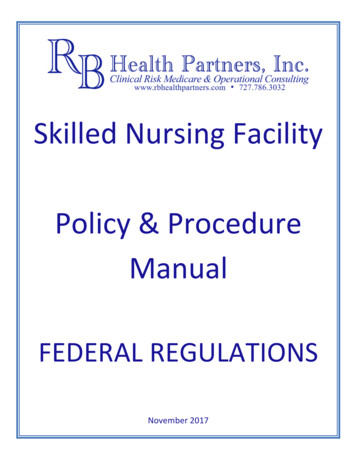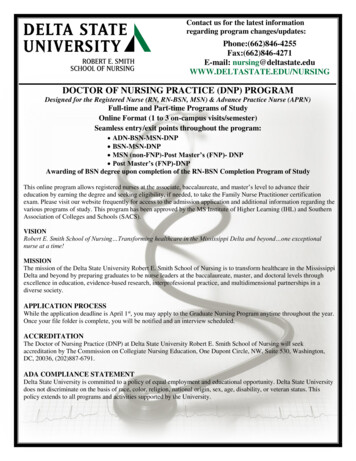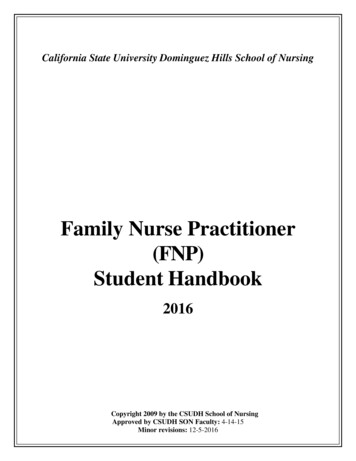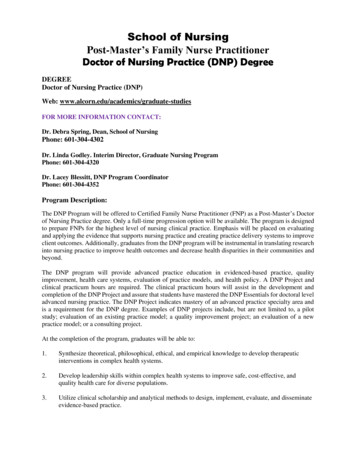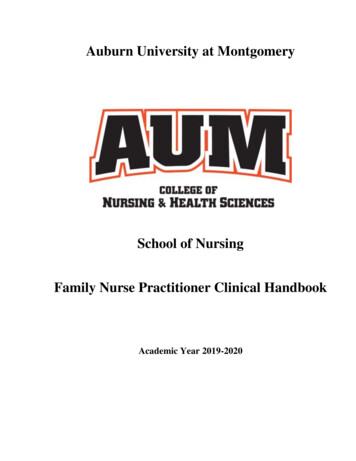
Transcription
Auburn University at MontgomerySchool of NursingFamily Nurse Practitioner Clinical HandbookAcademic Year 2019-20200
Table of ContentsMessage from the Dean . 4Program Outcomes . 5Nurse Practitioner Core Competencies Content . 6Nurse Practitioner Core Competencies with Suggested Curriculum Content . 0Family Nurse Practitioner Competencies . 28Health Promotion, Health Protection, Disease Prevention, and Treatment . 28I.A.Assessment of Health Status . 28B.Diagnosis of Health Status . 29C.Plan of Care and Implementation of Treatment . 29II.Nurse Practitioner-Patient Relationship . 30III.Teaching-Coaching Function . 30IV.Professional Role . 31Managing and Negotiating Health Care Delivery Systems . 31V.VI.Monitoring and Ensuring the Quality of Health Care . 31VII.Cultural Competence . 31Track Curriculum: Post-Graduate FNP Certificate . 32Clinical Course Expectations . 34Safe practice guidelines . 34Unsatisfactory/unsafe practices . 35Critical unsatisfactory/unsafe practices . 35Incident reports and clinical review panel process . 35Clinical Accountability. 36Clinical Courses . 37Typhon . 38Clinical Documentation System – Typhon. 39Clinical Preceptors . 40Preceptor Orientation . 40Arranging Clinical Preceptor for Practicum Experience . 40Clinical/Site Visit Protocol . 41Program-Specific Clinical Site Visit Objectives . 42Family Nurse Practitioner: . 42Clinical Hour Expectations . 421
Prerequisites . 43Castlebranch . 44Clinical Area Illness or Injury . 44Completion of Hours . 45Clinical Site Selection . 45Preceptor Selection . 46Suggestions for securing a Clinical Site and Preceptor . 46Preceptorship Planning for Auburn University at Montgomery School of Nursing . 46Procedure for Students: . 47Information for the Preceptor of the AUM School of Nursing . 48Nurse Practitioner Student. 48Example of Letter Sent to Your Preceptor(s) From FNP Faculty . 51Expected Family Nurse Practitioner Student Behaviors . 52Clinical Uniform Policy. 53Clinical Role and FNP Scope of Practice . 54Maintain Satisfactory Clinical Standing . 54Chart Documentation . 55Billing for Services . 56Family Nurse Practitioner Program Clinical Standing/Probation/Progression . 57Clinical Standing/Clinical Performance Evaluations . 57Clinical Probation . 58Probationary Action Form . 60Part A. 60Probationary Action Form . 61Part B . 61Progression Policies . 62Appendix A . 64Family Nurse Practitioner or Clinical Placement Planning Form . 65Part A- Student Information . 65Part B- Preceptor Information (must be completed in full) . 66Part C- Preceptor’s Practice Information . 68Clinic/ Agency Preceptor’s Information . 68Part D- Affiliated Hospital Information . 692
Appendix B . 70Information for the Preceptor of the AUM School of Nursing Nurse Practitioner Student . 71Appendix C . 74Expected Family Nurse Practitioner Student Behaviors . 75Appendix D . 76Auburn University at Montgomery School of Nursing Clinical Skills Checklist . 77Auburn University Schools of Nursing Clinical Skills Checklist . 78MSN FNP Program Clinical Evaluation of Student . 79Nurse Practitioner Student Evaluation of Preceptor . 80Appendix E . 82Graduate Program Occurrence Report Form . 83Remediation/Performance Improvement Plan . 843
Message from the DeanDear Graduate Nursing Student,Welcome to the College of Nursing and Health Sciences (CONHS) at Auburn University at Montgomery(AUM). We are delighted that you have chosen to pursue your degree at AUM in the School of Nursing. Ournursing program has a rich history of excellence in nursing education. Over the years we have developed newprogram options to increase access to education; and we are committed to helping you achieve your educationalgoals. The university core values serve as a foundation to the education of our students and are embraced by thefaculty and staff: a student centered experience, citizenship and community, standard of excellence,commitment to constant improvement, diversity of people and perspective with a culture of inclusiveness,promotion of lifelong learning and an environment of collaboration.This handbook will serve as a useful guide and resource during your nursing education at AUM. It is importantthat you review the policies and procedures included as they relate to many aspects of your educationalexperiences at AUM. Policies and procedures that are altered during the year will be communicated to youelectronically. A copy of the Student Handbook with up-to-date information is always available on the Schoolof Nursing website.On behalf of the college, its faculty and staff, please accept our best wishes for a personally fulfilling andsuccessful year.Sincerely,Jean D’Meza Leuner PhD., RN, CNE, FAANBarbara S. Witt Professor and DeanAUM College of Nursing and Health Sciences4
Program OutcomesThe Auburn University at Montgomery (AUM), School of Nursing (SON) Master of Science in Nursing andPost-Graduate FNP Certificate programs prepares students to:1. Initiate communication and collaboration with patient, patients’ support networks and healthcare(Essential II and VII)2. Utilize informatics and communication technologies to enhance patient education, expand accessibilityof care, analyze performance measures and improve outcomes. (Essential III, V, and VIII)3. Apply advanced concepts in the care of diverse populations through systemic assessment of actual andpotential risks in multiple care environments. (Essential I, II, and VIII)4. Influence health care policies to improve access, equity, efficiency, and social justice by utilizing clinicaljudgment, evidence-based findings and theory in delivery of healthcare. (Essential I, IV, VIII, and IX)5. Develop strategies for lifelong learning and interprofessional collaboration that integrate professionalstandards, guidelines, statues, regulations, and accountability in coordination of care.(Essential V, VI, VII, and IX).6. Recognize global factors to intervene and advocate for health promotion, clinical prevention, and diseasemanagement (Essential I, VI, VIII, and IX)7. Provide ethical, culturally sensitive, patient centered care based on epidemiological, social andenvironment data to improve health status. (Essential VI, VIII, and IX)8. Apply healthcare economics and leadership skills, managing micro-, meso-, and macro-systems forcontinuous quality improvement processes. (Essential II, III, VI)9. Apply scientific and ethical principles of emerging and current technology in delivery of direct andindirect care to promote safe practice environments. (Essential I, IV, V, and IX)5
Nurse Practitioner Core Competencies ContentA delineation of suggested content specific to the NP core competencies2017NP Core Competencies Content Work GroupAnne Thomas (Chair), PhD, ANP-BC, GNP, FAANPM. Katherine Crabtree, DNSc, APN-BC, FAAN KathleenDelaney, PhD, PMH-NP, FAANMary Anne Dumas, PhD, RN, FNP-BC, GNP-BC, FAANP, FAANRuth Kleinpell, PhD, RN, FAAN, FCCM JulieMarfell, DNP, APRN, FNP-BC, FAANPDonna Nativio, PhD, CRNP, FAAN, FAANPKimberly Udlis, PhD, FNP-BC, APNP AndreaWolf, DNP, CRNP6
Acknowledgments: NONPF also wishes to recognize members of the Curricular Leadership Committee who provided review andcomment on the draft document. The comments from the following people shaped the final document: Susan Buchholz, Holly Dileo,Kathy Dontje, Judith Haber, Ann Marie Hart, Kathleen Reeve, Susan Ruppert, Susan Schaffer, and Courtney Young.* The 2017 Nurse Practitioner Core Competencies Content publication aligns the competencies with the 2016 Adult-GerontologyAcute Care And Primary Care NP Competencies.7
Nurse Practitioner Core Competencies with Suggested Curriculum Content2017In the development of the nurse practitioner (NP) population-focused competencies, a task force had extensive discussions ofcompetencies vs. content. The task force concluded that it would be beneficial to programs if some content could be included asexemplars of how to support curriculum development for addressing a competency. Within the 2013 edition of the NP populationfocused competencies, the final column in each population’s competency table presents the respective competency work group’s ideas ofrelevant content.NONPF convened a work group to identify the suggested curriculum content for the NP Core Competencies. This work group consisted ofmembers of the task force that prepared the 2014 edition of the NP Core Competencies, as well as additional representation from the NONPFBoard and Curricular Leadership Committee. A sub-group of the NONPF Curricular Leadership Committee completed a review of the draftcontent, and the work group incorporated the review feedback into the final document presented herein. Please see the cover page for a list ofwork group members and an acknowledgment of the reviewers.The table that follows includes the NP Core Competencies and a list of suggested curriculum content. NONPF does not intend for the requirementof all of this content, nor is the content list comprehensive for all that a program would cover with population-focused competencies. The contentcolumn reflects only suggestions for content relative to the core competencies. This document should be used in combination with the populationfocused competencies.0
CompetencyAreaScientificFoundationCompetenciesNP Core CompetenciesCurriculum Content to Support CompetenciesNeither required nor comprehensive, this list reflectsonly suggested content specific to the corecompetenciesComparison of patient data sets with evidence-based standards toimprove care1.Critically analyzes data and evidence for improvingadvanced nursing practice.2.Integrates knowledge from the humanities and scienceswithin the context of nursing science.3.Translates research and other forms of knowledge toimprove practice processes and outcomes.4.Develops new practice approaches based on the integrationof research, theory, and practice knowledge.1Scientific foundations to practice, including, but not limited to,knowledge of advanced pathophysiology, pharmacology, physiology,genetics, and communication skillsScience from other disciplines relevant to health care
CompetencyAreaNP Core CompetenciesCurriculum Content to Support CompetenciesNeither required nor comprehensive, this list reflectsonly suggested content specific to the corecompetenciesTheories/conceptual frameworks/principles for practice: Translational research that guides practiceCritical evaluation of research findingsMid-range nursing theories and concepts to guide nursingpracticeEvidence-based havior changePopulation healthCritical thinking development: Evidence appraisalFormulating a practice problemUse of science-based theories and concepts to assess,enhance, and ameliorate health care delivery phenomenaUse of PICO questions to initiate research and qualityimprovement projectsQualitative and quantitative research and quality improvementmethodsEthical and legal protection of human subjectsInquiry processes and practices related to health literacy, vulnerablepopulations, and cultureMonitoring of health outcomesLeadershipCompetencies1.2.Assumes complex and advanced leadership roles to initiateand guide change.Provides leadership to foster collaboration with multiple10Content related to: Crisis management and leadershipStress management (for staff and patient/family)Teams and teamwork, including team leadership, building
CompetencyAreaNP Core CompetenciesCurriculum Content to Support CompetenciesNeither required nor comprehensive, this list reflectsonly suggested content specific to the corecompetenciesstakeholders (e.g. patients, community, integrated healthcare teams, and policy makers) to improve health care.3.Demonstrates leadership that uses critical and reflectivethinking.effective teams, and nurturing teamLeadership, change, and management theories with application topracticePolitical processes, political decision making processes, and healthcare advocacy4.Advocates for improved access, quality and cost effectivehealth care.5.Advances practice through the development andimplementation of innovations incorporating principles ofchange.6.Communicates practice knowledge effectively, both orallyand in writing.Problem solving: Influencing and negotiationConflict managementStrategic thinkingManaging changeBusiness development:7.Participates in professional organizations and activities thatinfluence advanced practice nursing and/or healthoutcomes of a population focus. High reliability organization principlesBuilding and maintaining effective teamsProject management conceptsPrinciples of effective decision makingPrinciples of change managementCivilityPrinciples of innovationCommunications: Scholarly writing, manuscript, and abstract preparationStructuring and presenting persuasive argumentsPeer review: ip development:11
CompetencyAreaNP Core CompetenciesCurriculum Content to Support CompetenciesNeither required nor comprehensive, this list reflectsonly suggested content specific to the corecompetencies Skills to influence decision-making bodies at the system,state, or national levelInterprofessional leadershipAssuming leadership positions in professional, political, orregulatory organizationsStructure and functions of editorial/board rolesEthical and critical decision making, effective workingrelationships, and a systems-perspectiveConcepts of strategic planning processLeadership stylesHow to lead change in practice, manage practice changes Monitoring implementation and fidelityAdaptation of change to patients, providers andorganizational needs and resourcesInterim feedback on achievements and efficienciesInterpretation of data and articulating evidenceSelf-reflection of leadership style e.g., personal leadership strengthsand weaknesses; working with diverse skills sets and diverse teamsQualityCompetencies1.2.3.4.Quality Safety Education in Nursing (QSEN) principles and contentUses best available evidence to continuously improvequality of clinical practice.Evaluation of outcomes of care such as quality improvement projectswith an evaluation componentEvaluates the relationships among access, cost, quality, andsafety and their influence on health care.Evaluates how organizational structure, care processes,financing, marketing, and policy decisions impact thequality of health care.Applies skills in peer review to promote a culture of12Reflective practiceCulture of safetyQuality improvement processes and practicesKnowledge of quality improvement methods such as: Plan-Do-Study Act Six Sigma
CompetencyAreaNP Core CompetenciesCurriculum Content to Support CompetenciesNeither required nor comprehensive, this list reflectsonly suggested content specific to the corecompetenciesexcellence.Cost benefit analysis5.Anticipates variations in practice and is proactive inimplementing interventions to ensure qualityPeer review process Reviewer RevieweeCollaborative team processes and practicesLeadership skills for leading change for quality clinical practiceMethods and measures of quality assurance during transitions ofcareLaws and rules to enhance quality such as Meaningful use Federal, state, and local quality data sources and indicatorsPractice InquiryCompetencies1.Provides leadership in the translation of new knowledgeinto practice.2.Generates knowledge from clinical practice to improvepractice and patient outcomes.3.Applies clinical investigative skills to improve healthoutcomes.4.Leads practice inquiry, individually or in partnership withothers.5.Disseminates evidence from inquiry to diverse audiencesusing multiple modalities.6.Analyzes clinical guidelines for individualized application intopracticeLeadership for role in practice improvementClinical investigation strategies: 13Identifying clinical practice problemsAppraising evidence for application to practice (e.g., design,methods, tools, analysis)Literature search methods, including, but not limited to, thePICO Model to define a clinical questions and search for thebest clinical evidenceUse of electronic databases, such as electronic health records: Assessing clinical practiceReviewing patient technologyExploring behaviors and risk factorsUsing data to support evidence based changes in clinicalmanagementTemplate development
CompetencyAreaNP Core CompetenciesCurriculum Content to Support CompetenciesNeither required nor comprehensive, this list reflectsonly suggested content specific to the corecompetenciesPatient management, including, but not limited to, discerning gaps incare and barriers to care needing resolution during patientencountersProject development and management: Synthesis and translation/extrapolation of research toselected populationsFrameworks to guide projectsQuality improvement methodsAssessment of resources needed and available for projectsCompeting priorities of patients, payers, providers, andsuppliersData-based, needs assessment for projectProcesses used in conducting projects based on currentand best evidence, including evaluation of the application ofevidence or inquiry to the population of concernEvaluation of outcomes (for health status of patient andpopulation as well as system outcomes)Evaluation of why expected results were or were notattained and lessons learnedMaking recommendations for further workAddressing issues of sustainability of project findingsDissemination of work and findings: 14Abstract and manuscript writing to support thedissemination of project/research outcomesDiscussion of clinically meaningful results that may or maynot be statistically significantPresentation skill development with modification for differentaudiences
CompetencyAreaNP Core CompetenciesCurriculum Content to Support CompetenciesNeither required nor comprehensive, this list reflectsonly suggested content specific to the corecompetenciesIntegration of findings: Results, methods, and tools, as appropriate, into caredeliveryIdentification of best practicesOpportunities for multidisciplinary team/inter-professionalcollaboration for patient careDevelopment and use of clinical guidelinesUse of clinical judgment to improve practiceApplication of evidence to validate or change policyEvaluation of alternative care delivery models and treatments,including costs, cost benefits, and return on investmentInstitutional review board policies and processesInterprofessional research and scholarship exemplars andopportunities15
Technology andInformationLiteracyCompetencies1.Integrates appropriate technologies for knowledgemanagement to improve health care.2.Translates technical and scientificappropriate for various users’ needs.health information2.a Assesses the patient’s and caregiver’s educationalneeds to provide effective, personalized health care.2.b Coaches the patient and caregiver for positivebehavioral change.3.Demonstrates information literacy skills in complex decisionmaking.4.Contributes to the design of clinical information systems16Technology available in clinical practice: Electronic resources that identify current evidenced-basedcare Electronic resources that enhance patient safety Technological care delivery systems Telehealth Information databases used by health care systems Electronic communication with other professionals andpatients Encrypted and unencrypted technology Electronic resources to support differential diagnosis,algorithmic thinking, and medical record review Templates for documentation in nursing care Use of electronic datasets to evaluate practice and improvequality, cost, and efficiency of careTechnology available to support education: Standardized patient encounters Electronic/computer based learning modules based oncharacteristics such as cultural literacy, educational level,
CompetencyAreaNP Core CompetenciesCurriculum Content to Support CompetenciesNeither required nor comprehensive, this list reflectsonly suggested content specific to the corecompetenciesthat promote safe, quality and cost effective care. 5.Uses technology systems that capture data on variables
Aug 16, 2019 · Nurse Practitioner Core Competencies with Suggested Curriculum Content 2017 In the development of the nurse practitioner (NP) population-focused competencies, a task force had extensive discussions of competencies vs. content. The task force concluded that it would be be
